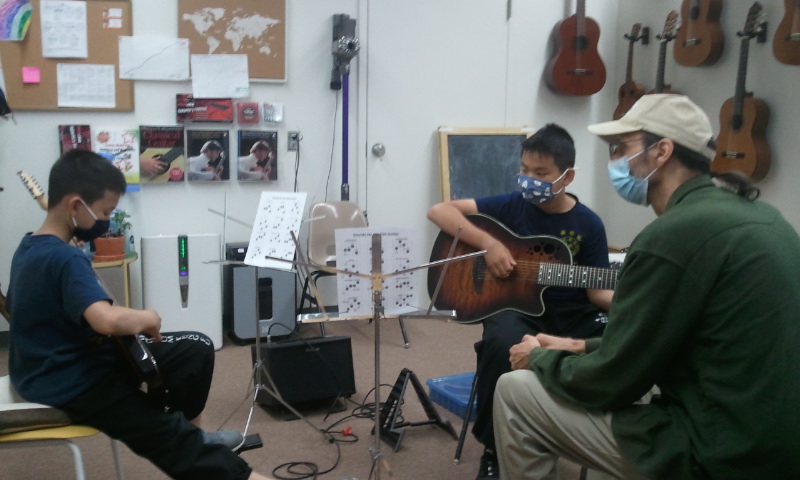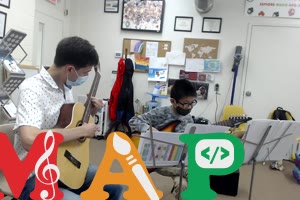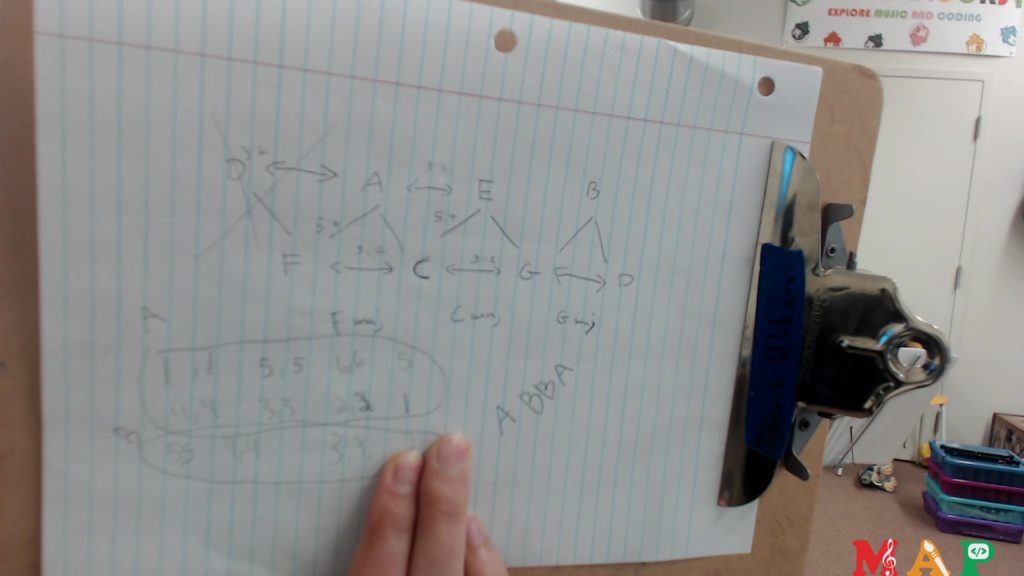[NOTE: This article has been edited on 8/30 for minor corrections and improvements.]
At MAP Family Learning Center, we are always looking for new, innovative ways to explore musical concepts. The Kite Guitar, invented in 2019 by Kite Giedraitis, is a great way to explore Just Intonation (music) as well as fractions (math). This article tells how we worked with our intermediate students to figure out “Twinkle Twinkle” on the Kite Guitar and what we learned along the way.
What is the Kite Guitar?
The Kite Guitar is a microtonal guitar, meaning it has a different division of the octave than the prevailing “12 equal divisions of the octave”. Musicians and music educators reading this will recognize that microtonality is not something typically taught to young students. In fact, a musician could go through prep school, undergraduate studies, and graduate studies at a university or conservatory and never once be required to study–or even be exposed to–microtonality!!

What is Microtonality?
Microtonality is presumed to be “esoteric”, “niche”, and “advanced”. In fact, I had some of these same presumptions myself. However, the folks of the Kite Guitar have been generous with their knowledge and time and have shown me that microtonality can–and, arguably should–be simple and accessible!
How did the Kite Guitar and its Knowledge come to MAP?
After learning a few things by going to weekly meetings, creating fretboard simulations with Music Blocks, reading their very insightful documentation, and receiving a Kite Guitar myself, I decided to share the fruits of my explorations with my guitar students.
In late June, Kite Guitar creator, Kite Giedraitis, visited Malden MAP, bringing two Kite Guitars, and giving an in-person workshop to a few of our lucky students.

A Simple Start — “Twinkle, Twinkle” on the Kite Guitar
“Twinkle, Twinkle Little Star”, I thought, would be a great start for two of my guitar students at MAP. These two students are fairly advanced on a standard (i.e. non-microtonal) guitar and can play intermediate-level music. However, since the Kite Guitar is quite different conceptually than a standard guitar, I decided to start simple.
We chose “Twinkle, Twinkle Little Star” which is entirely diatonic (i.e. can be played without black keys on a keyboard), uses just 6 pitches in the melody, and has a simple ABBA form. Moreover, since the melody is so familiar students can be quick to error-detect and correct if and when they make a mistake. (We all make mistakes — That is how we learn!)
Below is a video of the first lesson of “Twinkle, Twinkle Little Star” on the Kite Guitar. In many ways, it was a historic moment as Kite Guitar, only having been discovered a few years prior (one of which was during a global pandemic) is still a pioneering effort.
Video of Mr. Devin teaching a student how to play “Twinkle Twinkle” on the Kite Guitar.

Editorial Note: In the video, I say “third kite”, which would be way higher up on the neck. The correct term, consistent with the Kite Guitar terminology, would be “triple dot”.
Why Kite Guitar?
A melody like “Twinkle, Twinkle Little Star” can be played on a standard guitar, of course. However, by challenging oneself to figure out the same melody on the Kite Guitar we can begin a journey into learning about Just Intonation (music), of which is made accessible by the Kite Guitar, as well as acoustics (physics) and fractions (math).
The musical result of this challenge is a more in-tune, sonorous “Twinkle, Twinkle”. These concepts cannot be explored on a standard guitar. Also, a standard guitar will be more out-of-tune to Just Intonation.
In order to bring to surface some of these concepts, the students and I created lattices to determine which “D” (or “Re”, 2nd Scale Degree) to use. Below is an image of our work.

The Math and Music Behind the Lattice
An in-depth explanation of lattices is outside of the scope of this article. However, basically we had a choice between two different types of “D”. One of which is tuned by 3:2 perfect fifths from C ( C <–> G <–> D). This results in 3/2 * 3/2 = 9/4. The other is tuned by 5:4 to E from C, then down by 4:3 perfect fourths. This results in 5/4 * 4/3 * 4/3 = 80/36 = 20/9. The former results in 9/4 = 2.25 and the latter results in 20/9 = 2.2223. The difference seems small as a number, but is perceptible to the ear. Moreover, the Kite Guitar allows us to play either type of “D” to test the difference.
On a standard guitar, there is only one type of “D” making the exercise impossible. The Kite Guitar makes such a study possible, as well as practical. (The fretboard layout for the Kite Guitar is surprisingly easy to learn.)
Implications for Education
As I hope is evident by this article, what may seem like a simple lesson of a simple children’s song actually has many other things going on. Yes, we learned “Twinkle, Twinkle Little Star”. Yes, we used very simple fractions, which are presumably thoroughly taught in every school. However, we did many things that are unique to an integrated approach to music education. For example, we used math to calculate the expected outcome of the music, and then we tested our hypothesis (i.e. scientific method). We also tried something that most music schools for children wouldn’t even think of trying — we taught our students how to figure out a familiar melody on a new and novel instrument (i.e. breaking new ground, innovation, research, and problem solving).
Conclusions and Next Steps
The students who participated in learning music and theory on the Kite Guitar reacted very positively. They participated very well and were able to figure out a lot of the math on their own. They were also able to identify the differences of the various types of pitches by ear (e.g. which “D” sounds good within which context.) Therefore, we have continued the curriculum and plan to develop it further.
As a start, I have begun to write some of the exercises and music on my Github page, which may be downloaded, shared, remixed, and redistributed. I encourage my students and colleagues to do so.
What I expect to come from such an exploration is that my students have a better awareness of the inherent issues that arise with tuning and temperament. Unfortunately (but please correct me in the comments below if I am wrong), there is not a lot of research into “microtonality pedagogy”. However, given the mathematical and musical basis for microtonality and the Kite Guitar, I expect that exposing young students early in their education would improve their understanding of tuning and temperament. This understanding should result in students who are better equipped to avoid the most common pitfalls of, for example, tuning a guitar (or other instrument) or leading a choir.
Moreover, at MAP, we expect our students to create, discover, and to explore ideas in more than one way. Bravo!
